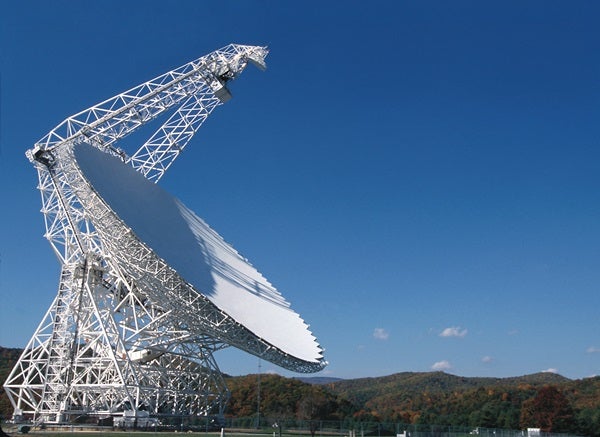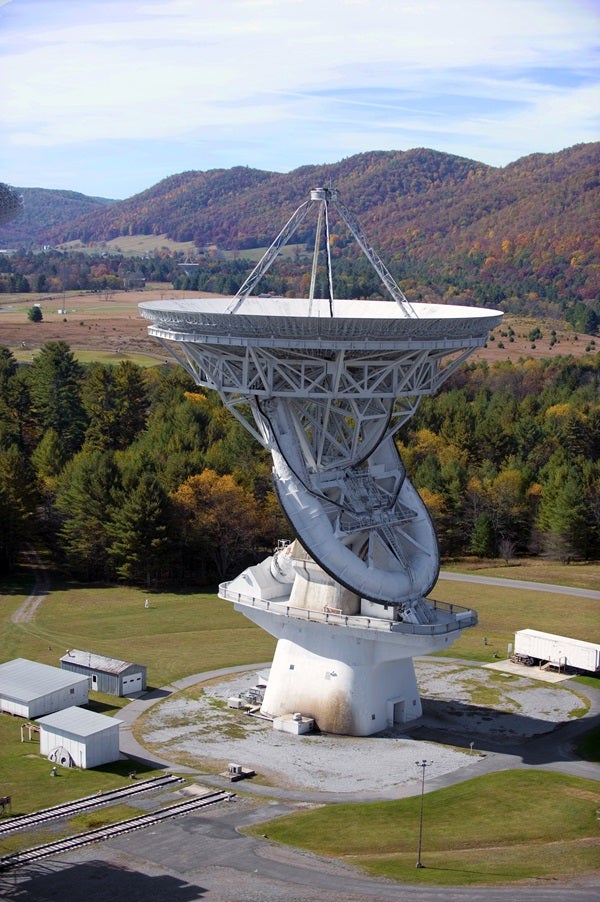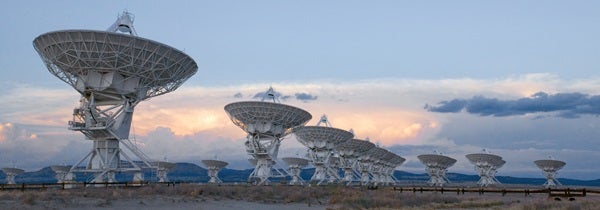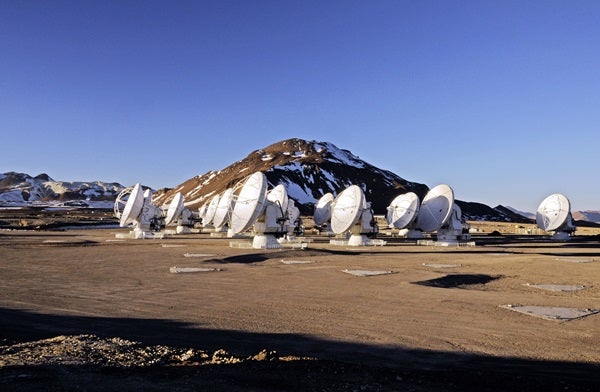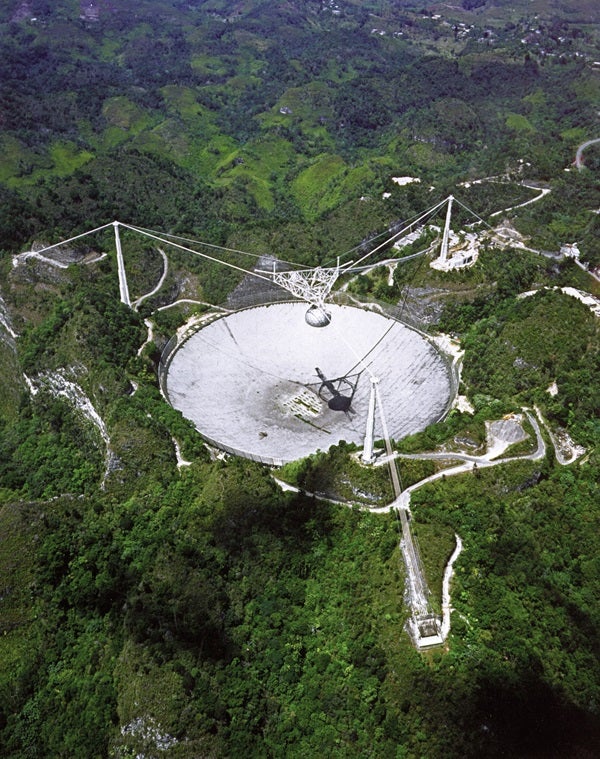The pursuit of radio astronomy is a quest for cosmic whispers. By the time radio telescopes collect them, the universe’s broadcasts are but a billionth of a billionth the power of a cellphone ping. To have any hope of detecting the cries of infant and dying stars, the subtle shimmying of molecules in gaseous clouds, or the faint ignitions of the early universe, radio astronomers must invent new technologies, plug them into huge sophisticated telescopes, and safely plant them in the most remote and, often, most extreme locations on Earth.
NRAO
Green Bank, West Virginia
Enclosed in 13,000 square miles (33,700 square kilometers) of federally mandated radio-quiet zoning, Green Bank’s forests are free from cell towers. However, nine research antennas and three historic ones poke out among the conifers, and visitors can pedal freely around them on bikes or take a guided bus tour that visits most of them.
The first large dish in view is the 85-foot (26 meters) Tatel, an Erector Set-like radio telescope skulking behind its old control building. In 1960, under the command of astronomer Frank Drake, this telescope was the first in the world used for the Search for Extraterrestrial Intelligence (SETI) research.
Across from the Tatel is the U.S. Naval Observatory’s former 20-meter geodetic telescope now being resurrected as a robotic instrument for citizen scientists.
The road bends around “the beautiful brute,” a 140-foot (43m) aperture radio telescope completed in 1965 and reigning still as the largest equatorially mounted telescope in the world. Its polar shaft is topped with a 17.5-foot (5.3m), 150-ton nickel-steel bearing, the biggest ever cast. This scope discovered several organic molecules in space, spearheading the field of astrochemistry.
With a later reconfiguration from prime focus to a Cassegrain feed, and the addition of new receivers and a computer control system, the renamed “43-meter” now studies Earth’s ionosphere and hunts for cosmic radio bursts.
At the bottom of the valley lurks the world’s largest fully steerable telescope, the Robert C. Byrd Green Bank Telescope (GBT). Visitors disembark to gawk up at this colossal and unique feat of engineering. The use of digital cameras is forbidden so near a working radio telescope, but, frankly, any camera struggles to capture the entire view.
The GBT is a 328-foot by 361-foot (100m by 110m) section of a virtual 682-foot (208m) parabola, with a feed arm climbing the side. This 485-foot-high (148m) behemoth boasts more than 2 acres of collecting area, coated in a bright white, infrared-reflecting paint that makes it painful to look at in sunshine. For this huge dish to maintain its shape to within the thickness of a few sheets of paper, 2,209 robotic pistons responsively adjust the corners of each of its 2,004 aluminum surface panels.
Completed in 2000, this “Great Big Telescope” enjoys unblocked views of 85 percent of the celestial sphere. The axis of its altitude gear is supported above a sturdy-wheeled carriage that smoothly spins its 16-million-pound (7 million kilograms) burden, making it the largest moving man-made structure on Earth.
Thanks to the Gregorian secondary’s removable prime-focus receiver and a rotating turret packed with eight more below, the GBT can collect frequencies from 290 megahertz to 116 gigahertz and, in a single day, can examine the subsurfaces of the moons of Jupiter, discover pulsars, map passing asteroids, and track hydrogen clouds to clock the spins of their host galaxies, including our Milky Way.
The large, modern Green Bank Science Center offers visitors a café, restrooms, a well-stocked gift shop, and a hands-on radio astronomy learning center. Tip for chocolate lovers: Ask for a Bill Saxton cone.
VERY LARGE ARRAY
Plains of San Agustin, New Mexico
Past the charming old stockyard town of Magdalena, an ancient dry lakebed of the Plains of San Agustin forms a mountain-rimmed fortress, a natural radio-quiet sanctuary for the most versatile and powerful radio telescope in the world, the VLA.
Since 1981, more than 40 miles (65km) of recycled train tracks have traced out three 13-mile-long (21km) arms eponymously called the Wye because of its Y shape. Large red antenna transporters slowly haul and deposit 230-ton VLA telescopes to new locations along these tracks several times a year.
Depending on the configuration, all 27 working dishes of the VLA may be within sight of the visitors center or separated so widely along the Wye that many are but lonely sentinels far out on the plains. At those latter times, the resolution of the VLA’s highest frequency images is 0.04 arcsecond — that’s more than 10 times the resolution of the Hubble Space Telescope.
The National Radio Astronomy Observatory is now enhancing the VLA telescopes, fitting them with a suite of upgraded cryogenic receivers that receive frequencies from 1.0 to 50 gigahertz. Using laser timing, fiber optics, the sweeping sky effect of Earth’s spin, and a supercomputer working at 16 quadrillion operations a second, the 25-meter telescopes of the VLA will become one giant enhanced radio eye up to 22 miles (36km) across. This Explanded Very Large Array, as it will be known, should be completed in late 2012.
The visitors center has a theater, exhibits, and a full gift shop. A souvenir map details a self-guided walking tour that leads directly to one of the active telescopes. The wooden safety corral does not diminish the extraordinary sensation of looking up at one of these 94-foot-tall (29m) giants.
A side tour steers visitors to the enormous Antenna Assembly Building (AAB), almost always occupied by a telescope in need of repair, with a 28th (spare) telescope replacing it in the array. With lucky timing, visitors can watch the transporters swap the AAB’s enormous occupants. Tip: For the best chance of a visit while transporters are rearranging the array, pick a date outside the “Observing Periods” listed in the VLA configuration calendar at https://science.nrao.edu/facilities/evla/index.
The VLA grounds are open to visitors every day from 8:30 A.M. Mountain time until dusk, with exclusive behind-the-scenes tours on the first Saturday of every month.
ALMA
Atacama Desert, Chile
A wide, flat road climbs eastward into the martian-like landscape of eroded fault lines, dry riverbeds, and windswept dunes. Against mesmeric dark blue skies loom the cones of extinct volcanoes, a few draped with natural masterpieces made by the golden hues of sulfur.
The dusty road finally crests a ridge, and suddenly spanning this otherworldy plain is a geometric display of bright armored radio telescopes, all staring at the firmament.
This is the Chajnantor Plateau in northern Chile, the 16,500-foot (5,000 meters) elevation home of the world’s most complex ground-based observatory, the Atacama Large Millimeter/submillimeter Array (ALMA). This facility combines the dreams of the National Radio Astronomy Observatory and its partners in Europe, East Asia, and the Republic of Chile.
By 2013, ALMA will be a reconfigurable array of 66 short-wavelength radio telescopes with two dish sizes. The twelve 7-meter telescopes sit in tight formation, flanked by four 12-meter telescopes, giving ALMA a constant high-sensitivity heart — the Atacama Compact Array. In addition, 50 more 12-meter telescopes in the main array can be moved, using the 28-wheeled ALMA transporters, to any of 192 pads across Chajnantor Plateau.
Behind the Cassegrain focus of each telescope hangs a cryogenically cooled thermos and receivers sensitive between 84 and 720 gigahertz. At its greatest span of 10 miles (16 kilometers), ALMA’s resolution is an unrivaled 0.005 arcsecond using its highest frequency.
With only half the atmosphere present at sea level, extreme ultraviolet levels, and wind chills usually below freezing, workers and telescopes alike must be well protected. Each of the weather-clad telescopes is linked by underground fiber optics to the 17 PetaOp-speed ALMA Correlator supercomputer and its precision timing
oscillators, protected inside a pressurized and climate-controlled space station-like facility.
Down at a more humane elevation of 9,500 feet (2,900m), the ALMA Operations Support Facility hosts hundreds of multinational staff. Here, the partners’ telescopes are assembled and delivered to ALMA’s high-tech telescope boot camp.
Round-the-clock shifts of radio astronomers and engineers test, tweak, and graduate each ALMA telescope. Whenever they slew the growing array across the sky, these folks are the first to see ALMA’s early wonders, such as the previously unresolved star-forming regions in the colliding Antennae Galaxies.
Tip: Watch the ALMA construction at www.almaobservatory.org/en/live-from-the-alma-site/live-from-chajnantor.
ARECIBO
Arecibo, Puerto Rico
At 1,000 feet (305 meters) across, the spherical dish at Arecibo cannot move. A trampoline of strong steel cables supports its 38,778 aluminum panels, and, suspended above this surface, a traveling 900-ton platform carries the receivers.
Arecibo tunes to cosmic frequencies between 50 megahertz and 10 gigahertz using a Gregorian receiver unit and a long antenna line feed. Astronomers time their observations for when their target enters a virtual observing cone swept out 20° from the zenith (the overhead point). Both receiver units can slide out along a revolving track that moves either into the reflected waves.
Completed in 1963, the Arecibo Observatory is the world’s most powerful radar transmitter. It studies Earth’s ionosphere, and its location near the equator allows astronomers to probe all of the planets, moons, and asteroids in our solar system. The 20-acre collecting area of the big dish has helped astronomers discover the first exoplanets and map the cosmic distribution of galaxies. Arecibo is possibly best known for broadcasting humanity’s first binary infographic message in 1974 in our search for extraterrestrial intelligences.
With some 54 inches (1.4m) of rain annually, temperatures in the upper 70s or low 80s, and a 500-step climb from the parking lot, visiting Arecibo is a sultry adventure. Entrance fees are rewarded with a goggling view of the dish below. The Angel Ramos Foundation Visitor Center has hands-on astronomy exhibits, a gift shop, and a café. Tip: A good map or GPS will make the winding rainforest drive a lot more enjoyable.
No matter their size, shape, or frequency, these powerful marvels of exploration eavesdrop exclusively on the universe’s most private affairs, giving us our clearest insights into the cycles of the cosmos. Scientists and engineers push the boundaries of technology and endurance to build the biggest and best telescopes for this quest, a fact that is not lost on any visitor to these, America’s greatest radio observatories.

